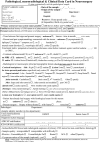French brain tumor database: 5-year histological results on 25 756 cases
- PMID: 21554472
- PMCID: PMC8094058
- DOI: 10.1111/j.1750-3639.2011.00491.x
French brain tumor database: 5-year histological results on 25 756 cases
Abstract
This work aimed to prospectively record all primary central nervous system tumor (PCNST) cases in France, for which histological diagnosis is available. The objectives were to (i) create a national registry and a network to perform epidemiological studies; (ii) implement clinical and basic research protocols; and (iii) harmonize the health care of patients affected by PCNST. For 5 years, 25 756 cases of newly diagnosed and histologically confirmed PCNST have been recorded. Histological diagnoses included glioma (48.9%), all other neuroepithelial tumors (5%), meningioma (28.8%), nerve sheath tumors (8.4%), lymphoma (3.2%) and others (5.7%). Cryopreservation was reported for 6018 PCNST specimens. Tumor resections (R) were performed in 78% cases, while biopsies accounted for 22%. Median age (MA), sex, percentage R and number of cryopreserved tumors were detailed for each histology; for example, out of 6053 glioblastomas (MA 63 years, male 59.4%, R 62%, 1611 were cryopreserved), and out of 37 atypical teratoid/rhabdoid tumors (MA 2 years, male 56.8%, R 94%, 17 were cryopreserved). This database or databank dedicated to PCNST cases contains detailed data on clinical, histological and other characteristics, such as the inclusion of data on cryopreserved specimens that are not available in other European registries. Therefore, this is a valuable resource that can be used for planning future epidemiological and clinical research.
© 2011 The Authors; Brain Pathology © 2011 International Society of Neuropathology.
Figures

References
-
- ADICAP, Association pour le Développement de l'Informatique en Cytologie et en Anatomie Pathologiques (2003) Database online. Edition 2003, version 5. Available at: http://www.adicap.asso.fr/THESAURUS/Adicap_v5‐03pdf (accessed 24 May 2011).
-
- Arora RS, Alston RD, Eden TOB, Estlin EJ, Moran A, Geraci M, Birch JM (2010) Are reported increases in incidence of primary CNS tumours real? An analysis of longitudinal trends in England, 1979–2003. Eur J Cancer 46:1607–1616. - PubMed
-
- Bauchet L, Capelle L, Stilhart B, Guyotat J, Pinelli C, Roches P et al (2004) French neurosurgical practice in neuro‐oncology (national survey—part I). Neurochirurgie 50:540–547. - PubMed
-
- Bauchet L, Rigau V, Mathieu‐Daudé H, Figarella‐Branger D, Hugues D, Palusseau L et al (2007) French brain tumor data bank: methodology and first results on 10,000 cases. J Neurooncol 84:189–199. - PubMed
-
- Bauchet L, Rigau V, Mathieu‐Daudé H, Figarella Branger D, Fabbro P, Taillandier L, Duffau H (2008) Towards an European brain tumor data bank. Neuro-Oncol 10:1134. [abstract].
Publication types
MeSH terms
LinkOut - more resources
Full Text Sources
Medical

